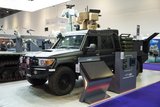Harris extends US Army wideband networking
Harris Corporation has announced that it has integrated wideband networking capabilities that that successfully connected dismounted soldiers to senior commanders within a Brigade Combat Team at the recent US Army Network Integration Evaluation. This is the first time such networking capabilities have been provided between two separate tactical networks.
According to the company, Harris deployed a two-channel Falcon III AN/PRC-117G vehicular system that transmitted voice and wideband data between the networks — analogous to a call or text message that moves from one carrier’s cellular phone to another. The system consisted of two AN/PRC-117G radios connected to each other in a vehicular amplifier adapter.
Soldiers at the NIE 12.1 also integrated the AN/PRC-117G with the new AN/PRC-152A wideband handheld radios to extend networking connectivity from brigade to the tactical edge. The extended system resulted in wideband communication services that covered all of White Sands, an area of 3,200 square miles.
Harris said the AN/PRC-152A was used to send voice, data, and position location information from the dismounted soldier over a backbone Adaptive Wideband Networking Waveform (ANW2) network. The AN/PRC-152A is the first NSA Type-1 certified handheld radio to offer wideband networking as well as standard legacy waveforms.
The two-channel AN/PRC-117G vehicular system at NIE 12.1 simultaneously operated two wideband waveforms. One radio operated the JTRS Soldier Radio Waveform (SRW), for communication from platoon levels through to company commands; the other radio ran ANW2 and transmitted voice and data from company to battalion and brigade. The Harris system moved information between the SRW and ANW2 networks, allowing for seamless communication across the battlefield, from platoon level to battalion and back.
According to Harris, once the data reached the ANW2 network, it was populated over the Army’s Warfighter Information Network-Tactical, providing a common operating picture from the foxhole to the brigade headquarters. Applications used over the Harris Falcon III radios were TIGR, file transfer, chat messages and email. During NIE 12.1, the Harris radios were deployed in rucksacks, vehicles, aerostats, fixed wing aircraft and RAID towers.
The Army also evaluated two additional wideband radio products from Harris: The Highband Networking Radio (HNRe2), which provides an IP-based network with links capable of throughput rates up to 27 Mbps, for VoIP, video and C4I services, and the RF-7800W High-Capacity Line-of-Sight radio, which delivers quick-to-deploy, point-to-point or point-to-multipoint wireless Internet Protocol infrastructure. During the NIE, the HNRe2 delivered nine nodes of critical communications — including IP transmission of ISR data — using terrestrial and airborne assets to establish a backbone network from brigade down to company echelons. The Army used the RF-7800W radios to provide remote video feeds to command posts, battalions and headquarters installations as well as an alternative data link between key nodes.
More from Digital Battlespace
-
![Babcock nears first customer for Nomad AI translation tool]()
Babcock nears first customer for Nomad AI translation tool
Nomad can provide militaries with real-time intelligence, saving critical time on the battlefield.
-
![AUSA 2025: Israel’s Asio Technologies to supply hundreds of improved Taurus tactical systems]()
AUSA 2025: Israel’s Asio Technologies to supply hundreds of improved Taurus tactical systems
Taurus operates alongside the Israel Defense Forces’ Orion system which supports mission management across tens of thousands of manoeuvring forces, from squad leaders to battalion commanders.
-
![AUSA 2025: Kopin pushes micro-LED plans as China moves faster]()
AUSA 2025: Kopin pushes micro-LED plans as China moves faster
The plan for the new displays follows fresh investment in Kopin’s European facilities by Theon and an order for head-up displays in fielded aircraft, with funding from the US Department of Defense.
-
![AUSA 2025: Persistent Systems to complete its largest order by year’s end]()
AUSA 2025: Persistent Systems to complete its largest order by year’s end
Persistent Systems received its largest ever single order for its MPU5 devices and other systems earlier this month and has already delivered the 50 units to the US Army’s 4th Infantry Division.
-
![Aselsan brings in dozens of companies and systems under the Steel Dome umbrella]()
Aselsan brings in dozens of companies and systems under the Steel Dome umbrella
Turkey has joined the family of countries attempting to establish a multilayered air defence system with government approval in August 2024 for the effort landed by Aselsan. Dubbed Steel Dome, the programme joins Israel’s Iron Dome, the US Golden Dome, India’s Mission Sudarshan Chakra and South Korea’s low-altitude missile defence system.
-
![DSEI 2025: MARSS unveils new agnostic multidomain C4 system]()
DSEI 2025: MARSS unveils new agnostic multidomain C4 system
MARSS’ NiDAR system has been deployed using sensors from static platforms to provide detection and protection for static sights, such as critical infrastructure, ports and military bases.




























